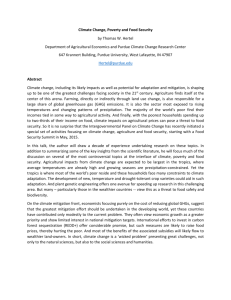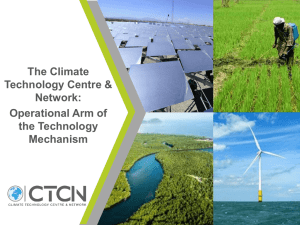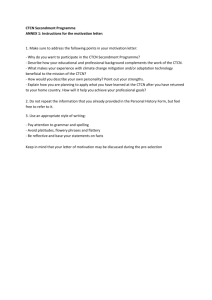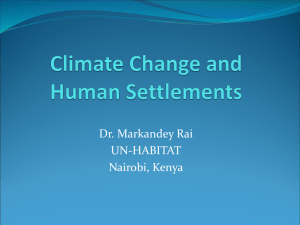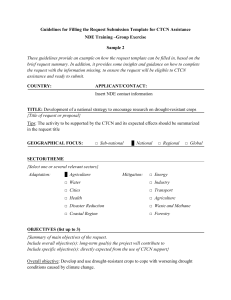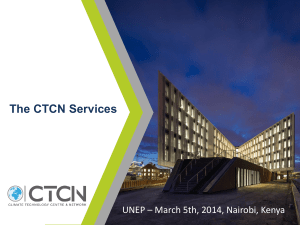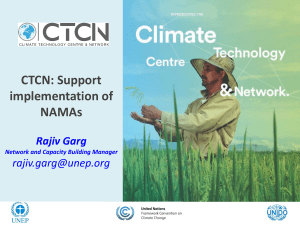Project mapping is a tool to systematically compile and structure
advertisement
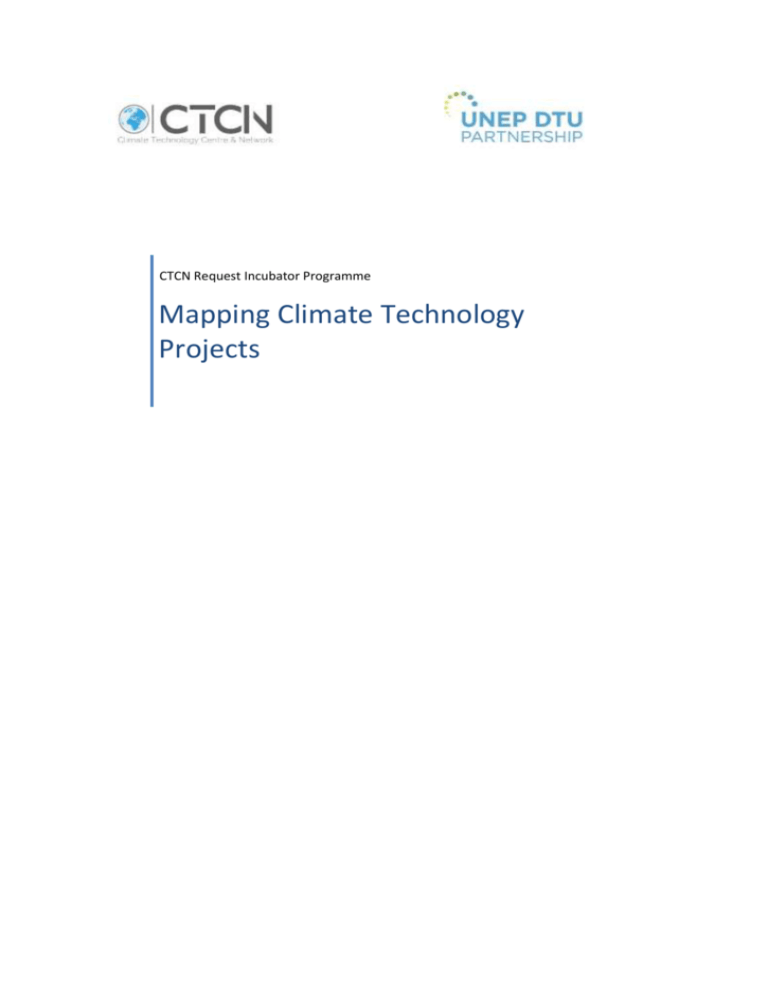
CTCN Request Incubator Programme Mapping Climate Technology Projects Table of Contents 1 2 Introduction .................................................................................................................................... 4 1.1 What do we mean by projects ................................................................................................ 4 1.2 What is project mapping ......................................................................................................... 5 1.3 Why project mapping.............................................................................................................. 5 1.4 Scope ....................................................................................................................................... 5 Step-by-step approach .................................................................................................................... 6 Step 1: Define purpose of assessment................................................................................................ 6 Step 2: Define scope of the assessment ............................................................................................. 6 Step 3: Identify, collect, and review relevant documents .................................................................. 7 Step 4 Conduct interviews with key sector experts............................................................................ 7 Step 5: Categorize the information collected ..................................................................................... 7 Step 6 Analyse outcomes of the overview.......................................................................................... 8 3 Best practice, project mapping ....................................................................................................... 9 4 From project mapping to CTCN Technical Assistance..................................................................... 9 Annex A ................................................................................................................................................. 10 Table A.1 Simple table showing technology component.................................................................. 10 Table A.2 Mapping of adaptation technologies in national documents........................................... 12 Table A.3 Detailed project overview ................................................................................................. 13 Annex B ................................................................................................................................................. 15 Table B.1 Simple project overview template for adaptation ............................................................ 15 Table B.2 Simple project overview template for mitigation ............................................................. 16 Table B.3 Simple project overview template for one sector, structured by technology category ... 17 Table B.4 Simple project overview template for one sector, structured by technology maturity ... 18 Table B.3 Detailed project overview template for adaptation, structured by sector ...................... 19 Table B.3 Detailed project overview template for mitigation, structured by sector........................ 20 1 Introduction Although technologies for climate change adaptation and mitigation presents a relatively new field, there are close linkages to existing business-as-usual development oriented projects. For example adaptation technology components could be identified in projects for poverty reduction, improved nutrition, enhanced education, expanded infrastructure, and improved health while improved economic efficiency of private industry and improvements in the transport sector could lead to reduced GHG emissions. The review of ongoing work will enable the NDE to identify current bottlenecks and barriers to technology deployment that could be removed by targeted technical assistance from the CTCN. This work will also help the NDE identify projects that successfully contributed to the deployment of technologies in the country and to identify technologies that are appropriate to the country context and that demonstrated economic social and environmental benefits. Supported by the regional CPs, NDEs will: Map past, on-going and planned national processes, projects and initiatives implemented in the country to tackle climate change related challenges and to deploy climate technologies Map past, on-going and planned bilateral projects and initiatives Map past, on-going and planned international projects and initiatives (such as UNFCCC commitments, climate technology projects funded by development financial institutions, etc.) The target group for this module includes various stakeholders, such as stakeholders from public, private and civil society. In order to submit quality requests to the CTCN, the NDEs needs to have an understanding of past and ongoing projects related to climate technologies, conducted by various stakeholders (public, private, and civil society) in order to ensure CTCN technical assistance can complement existing initiatives, taking into account lessons learned. This module provides the users with the ability to prepare an overview and understanding of past and ongoing projects related to climate technologies. The outlined steps help to gather, organize, categorize, and analyse information on climate change projects, collected from literature studies and interviews, and ensure CTCN technical assistance can complement existing initiatives, taking into account lessons learned. 1.1 What do we mean by projects A project means a series of activities that take place over a pre-determined period of time to achieve a specified aim. A project will be planned from beginning to end and have set targets. On the other hand, in making an overview of ongoing projects, it would also be useful to include other efforts to gain a comprehensive overview of climate technology related activities in the country. Thus, this would include past and ongoing processes, initiatives, country commitments under the UNFCCC, at the national, bilateral, multilateral level, where: A process could be a national plan which is an on-going process to bring about positive change, An initiative is a means to assemble a variety of inputs to achieve an outcome, for example specific projects or programs undertaken to achieve specific objectives in the near-term, with objectives to, for example, reduce costs, increase energy efficiency, reduce greenhouse gas emissions, and/or increase resilience to climate change. Country commitments, under the UNFCCC to address climate change, could be Nationally Appropriate Mitigation Actions (NAMAs) Projects vary in size of budget, scope, institutional development, capacity development, etc. 1.2 What is project mapping Project mapping is a tool to systematically compile and structure information on past, on-going, and planned activities within the identified scope of the assessment. 1.3 Why project mapping The review of past, ongoing, and planned projects will enable the NDE to identify current bottlenecks and barriers to technology deployment that could be removed by targeted technical assistance from the CTCN. This work will also help the NDE identify projects that successfully contributed to the deployment of technologies in the country and to identify technologies that are appropriate to the country context and has demonstrated economic, social and environmental benefits. 1.4 Scope An assessment of projects could be done with a multi-levels focus, being community, regional and/or national levels. It could be done taking a sector approach covering a variety of sectors, such as energy, agriculture, health, water, and infrastructure, or it could be a combination, or it could simply include all projects which have technology components of adaptation or/and mitigation. Keeping a too narrow focus, without considering other projects, could lead to missed opportunities. It is recommended to make separate project mapping for adaptation and mitigation projects to facilitate a better overview of gaps in the respective focus areas. 2 Step-by-step approach In the following, a simple step-by-step approach for preparing an overview of projects is outlined. Step 1: Define purpose of assessment As a first step in mapping past, on-going and planned projects, the following questions could be considered. 1. 2. 3. 4. Why is a project mapping being undertaken? What information is being sought? Who is the project mapping for? How will the results (findings) be used? Step 2: Define scope of the assessment The following questions could be used in defining the scope of the project mapping assessment. If a realistic scope is set, it will improve the ability of the NDE to make a good assessment, as well as it will easier allow for aa follow up later on, ion those areas that was considered out of scope for the assessment at this point in time. 1 Which implementation levels need to be assessed? This could be project/community/local level or regional/national level. For most assessments it is useful to include projects from all levels but then make a note in the overview to which level this project is implemented 2 Which sectors will be included? Depending on the objective of the mapping, the NDE could choose to focus the mapping on one or several sectors. For adaptation, it would typically water, agriculture, coastal zone, infrastructure and health. For mitigation, it would generally be energy, transport, buildings, and agriculture. Other sectors can be included. 3 Which type(s) of projects will be included? As previously mentioned, the assessment could include not only what is traditionally perceived as projects but also processes (plans), initiatives, and country commitments. Taking this 'multi-project' definition would improve the result of project mapping so that it gives a more complete and realistic overview of activities in the countries and ease the process of identifying where the country could benefit from targeted technical CTCN assistance. 4 What resources are needed? How much time does the NDE have for this task? The above demarcations should reflect the available time, and be adjusted accordingly. Focusing on selected priority sectors, making a good project mapping assessment, is preferable to a quick screening which in reality will not reflect the real state of projects in the country. Step 3: Identify, collect, and review relevant documents 1 Stock-take and review The NDE should consult the main climate change documents (strategies, capacity needs assessments, sectoral documents, etc.) produced at national, sub-national, and local levels, including the information in National Communications, NAPAs and other relevant studies on climate change. 2 Identify any potential literature sources The NDE should identify any relevant consultancy reports, academic papers, grey literature, etc. which could offset gaps into national policy documents on any relevant projects that could feed into making an overview of projects The following type of resources is examples of what could be useful literature for identifying relevant projects 1. National Communications submitted to the UNFCCC. 2. National Adaptation Programme of Action (NAPA). 3. National and sectoral programmes or strategies Step 4 Conduct interviews with key sector experts Consultations with a variety of stakeholders to gain information on past, on-going and planned development and/or climate change-related projects which have technology components, including 1. community level stakeholders 2. experts such as economists, agronomists, climatologists, hydrologists, finance experts, planners in central government, sub-national level institutions, academia, private sector and civil society 3. Other relevant stakeholders Conducting interviews as supplement to literature search can gain insights for example on projects which are not available online. There can be different reasons to why projects are not available online, but often the information gained from personal contact to stakeholders are more rich than what can be obtained from project web sites. Step 5: Categorize the information collected The NDE should now make an assessment of the information which has been collected during the project mapping exercise. It would be relevant to consider if the projects fit with the stated purpose and scope of the mapping. In addition, the projects could be categorized according to what has been identified in the scope of the project mapping (for example level and categories) and overview table(s) should be prepared. The design and structure of the overview table(s) could include different types and levels of information, depending on the objective of the project mapping. Templates for detailed and simpler project overviews are provided in Annex A. Depending of what the objective of the project mapping exercise is, the projects could be organised from a technology perspective, categorizing projects according to which type of technology (software, hardware or orgware) is the main component of the project. Or the table can simply list all projects within one or several sectors and group these according to technology components. When the first overview has been prepared, it should give an indication to the NDE if enough and adequate project information has been collected to start summarize and make observations. For example, are there any gaps where more information could be found through other source of information than what has been used already and would it be necessary to do a follow up with the stakeholders already interviewed, to fill potential gaps? Step 6 Analyse outcomes of the overview An analysis of the project overview could include some discussion on how well projects with technology components are covered in the different sectors, the size of a typical project, target groups/beneficiaries, target level (household, community, regional, national, etc), the cross cutting nature of the projects and so forth. For example projects in the water sector, which is often extensively covered by projects, are in most cases cross cutting, since water is a major contributor to agriculture, industry, energy, transport, land. Conclusions could also be drawn to whether projects have positive effects on general wellbeing aspects and/or on more specific land use and natural resource management issues, or if the projects tend to have given more attention to technical environmental aspects rather than to development aspects and social and economic dimensions. A project mapping exercise could also focus on incountry activities within a specific technology category to asses if the existing efforts are adequate to meet demands or in which way further work on technologies could contribute to meeting technology needs. In this step, it would be helpful to consider a number of questions, namely: Does help the information collected and classified through the project mapping contribute to the objective of the exercise? Have technology gaps emerged at different types, for example level (policy, organisational, and/or operation) categories (soft, hard, orgware technologies) maturity (being traditional, modern, high) This work will also help identify projects that successfully contributed to the deployment of technologies in the country and to identify technologies that are appropriate to the country context and that demonstrated economic social and environmental benefits. 3 Best practice, project mapping Define a clear and precise objective of making the project mapping. In most cases, the objective could simply be to prepare a mapping of all past, on-going and planned projects which are related to climate technologies to identify current bottlenecks and barriers to technology deployment that could be removed by targeted technical assistance from the CTCN. In other cases, the objective could be of a much lower-order, typically to assess projects supporting a single issue that is within the ability of one adaptation technology to tackle. In this case, it is recommended to define the problem in terms of how climate change will impact a key sector at the national, sub-national, or local level. For example the objective of the mapping could be to identify projects which include climate technologies which are relevant in the context of intensified and frequent coastal flooding due to climate change adversely affects community livelihood opportunities. Use a variety of sources to identify projects. The collected information on projects can be categorized according to sector, the adaptation/mitigation issue or something else. Ensure that national/sub-national policies and strategies (see training module 3), including ongoing and planned programmes/projects, are identified. This is important both in the context of understanding the issue which technologies are targeted towards and in identifying what is already in place to address the underlying causes of the problem/lack of transfer and diffusion of a specific climate technology. It is also helpful in determining the associated barriers that need to be overcome in order to effectively transfer and diffuse the selected technology. 4 From project mapping to CTCN Technical Assistance After preparing technology project databases by mapping projects and identifying technology gaps as illustrated above, the next step would be to prepare a summary of the information which could be drawn from the project overview, including enabling factors for projects that has led to successful deployment of climate technologies, what works and what doesn’t given the country specificities, what lessons can be learned from past successes and failures. In addition, an analysis of how these gaps can be addressed in the short and medium term, would also be relevant to make and how targeted technical assistance from the CTCN could help in remove obstacles top technology deployment. Annex A Table A.1 Simple table showing technology component Overview of Tanzanian climate change adaptation and vulnerability activities and other sector activities with major links to climate change vulnerability Focal Project Area Summary Technology component Water Sector Support Program The objective of this project is to support the GoT’s poverty alleviation strategy through the improvements in the governance of water resources management and the sustainable delivery of water supply and sanitation services. water resource management and supply technologies Monduli District Water Supply Project The project contributes to increase in coverage of rural water supply for domestic and livestock consumption, to community awareness of the need for better sanitation, to overall natural resources management in an arid area, and consequently to reduction of water related poverty in the selected areas of the Monduli District. rural water supply and awareness raising technologies Rural Water Supply and Sanitation Project (RWSSP) This project will improve the existing water supply, and sanitation schemes in rural areas, focusing on improved environment, sanitation, and hygiene conditions, with particular attention to HIV/AIDS prevention. rural water supply technologies Dar es Salaam Water Supply and Sanitation Project This project is to provide a reliable, affordable and sustainable water supply service and improve the sewerage and sanitation in the "service area" of the Dar es Salaam Water and Sewerage Authority (DAWASA). urban water supply service and improve the sewerage and sanitation Marine and Coastal Environment Management Project (MACEMP) The objective of the project is to improve sustainable management and use of the territorial seas and coastal resources. Sustainable management and use will be reflected in enhanced revenue collection, reduced threats to the environment, improved livelihoods of participating coastal communities and improved institutional arrangements. sustainable management technologies and use of the territorial seas and coastal resources Lake Victoria Environmental Management Project (LVEMP) The major objective of the project is to restore a healthy, varied lake ecosystem that is inherently stable and able to support, in a sustainable way, the increasing activities in the lake and its catchments for the benefit of the people of the riparian countries as well as the international community. The main objective of this project is to improve access to sustainable quality water supply and wastewater management services in the three regional centres of Mwanza, Iringa and Mbeya. ecosystem restoration technologies The development objective of the project is to consolidate and improve the conservation of the Malagarasi-Muyovozi wetland ecosystem conservation. (Software technologies) Water Water Supply Programme Regional Centres water supply and wastewater management technologies Wetlands Sustainable and Integrated Management of the MalagarasiMuyovozi Ramsar Site (SIMMORS) Sustainable Wetlands Management ecosystem and to improve the welfare and living standards of the communities living within and around the wetlands. The objective of this project is to implement sustainable wetland management approaches in Tanzania and contributing to improvement of livelihoods. sustainable wetland management technologies. (Software technologies) Agricultural Sector Programme Support (ASPS) – Phase II, Danida The ASPS II contains four components (a) Support for Policy and Regulatory Reforms, SPRR, (b) Private Agricultural Sector Support, PASS, (c) On-farm Seed Production; and (d) District Agricultural Development Support, DADS. The four components are designed to raise income of rural households and priority is given to measures that have rapid impact on incomes mix of different technologies for agricultural sector Small-Scale Irrigation at Pawaga This project aimed to construct civil engineering works that would include an access road, work camp, weir, intake structure, link canal, flood protection bunds, and an emergency spillway. agricultural irrigation technologies Agricultural Sector Development Program, World Bank Initial focus of program will be on areas where there are financing gaps and technical support needs. Given the multi-phased, long term technical and financial requirements of the program three phases are proposed, which would allow over a 9-10 year period support by development partners to the Government’s efforts. a wide range of agricultural technologies Agriculture Table A.2 Mapping of adaptation technologies in national documents. The table shows an example of mapping technologies in national documents. National documents Proposed adaptation technologies First Technology Need Assessment Report i (2004) - Second National Communication (2010)ii - Source: Mauritius TNA report 2013 Increasing water use efficiency through more performing irrigation systems; Trash blanketing / green cane harvesting (sugar cane) Changing harvest period; Land use change (shifting areas); Crop change - Adopting drought tolerant cultivars Introduction of more performing cultivars Integrated Pest management Rational use of fertilizers and herbicides Introduction of new varieties or cultivars; Shifting crop production zone. Increasing irrigation water requirement Sustainable land/ soil management of land/soil Promoting conservation and sustainable agricultural practices; Combating land degradation; Biotechnologies to improve water-use efficiency of crops or plant more resistant crop varieties; Provide farmers with Insurance and security for their investments; Application of new and sustainable technologies, e.g. protected cultivation; and Establishment of an early warning system for pest and disease management. Table A.3 Detailed project overview This table is an example of how project mapping can be used to collect experience and gain knowledge on a specific technology from regional experience. This can be useful in a situation where a technology has not yet been adopted in a country. In this case, project mapping at a regional level is used as a starting point for elaboration of a national framework for monitoring and evaluation adaptation in Colombia. The elaboration of a framework can then gain from the regional experiences identified during the project mapping within a specific field. Name of Monitoring and Evaluation framework Conceptual and Methodologi cal Guidelines of the Climatic Latin American Platform Sistema de Información de la Agenda de Transversalid ad (Information System of the Mainstreami ng Agenda) country Project Institution Audience Objective of the framework Indicator types link to framework Paraguay Programa Nacional del Cambio Climático (PNCC) (National Program for Climate Change) Programa Especial de Cambio Climático 2009-2012 (Special Program for Climate Change 20092012) Secretary of the Environmen t (SEAM) Government To measure the institutional progress in adaptation to climate change matters. Due to the early stage of the program (implemented in 2011), is not feasible to do a more deep evaluation in other areas For tracking the progress of the program, the evaluation focus on an analysis of the institutions created since the implementation of the program. To measure the impact of the program is not possible yet. http://intercambioclimatico.com/wpcontent/uploads/PARAGUAY-InformeFinal-Cambio-Clim%C3%A1tico.pdf Secretary of the Environmen t and Natural Resources (SEMARNAT ) Government Track overall program progress, through the setting of goals for adaptation and mitigation Percentage of achieved goals. Some examples of the goals are: To construct seven emergency centers to support the community in the case of an emergency, create models for the prediction of risk sceneries associated with climate change, reduce the use of fire as an usual practice in the agriculture sector in 11550 ha, etc. http://www.conagua.gob.mx/CONAG UA07/Contenido/Documentos/pecc12. pdf Mexico - Uruguay Four measures were evaluated, they don't belong to any particular program Monitoring Adaptation to Climate Change (MACC) Bolivia PACC Monitoring and Evaluation System Peru Programa de Desarrollo Agropecuario Sustentable (PROAGRO) (Sustainable Agricultural Development Program) Programa de Adaptación al Cambio Climático (PACC) (Adaptation to Climate Change Program) Ministry of Livestock, Agriculture and Fishing through the Agriculture Climate Change Unit and the FAO Ministry of Planning in cooperation with the GIZ Ministry of Environmen t of Peru and the Swiss Agency for Developme nt and Cooperatio n (SDC) Government Calculate the economic impact of each measure. Make an analysis of possibly barriers in their implementation, from the point of view of the supply Internal Rate of Return (IRR) of each project, interviews with qualified consultants from different stakeholders and a Multi Criteria Analysis http://www.mgap.gub.uy/opypapublic aciones/ANUARIOS/Anuario2013/mate rial/pdf/26.pdf Government and NGO Analyze the effectivity and efficiency of the program, to provide inputs for the design of the third stage of the program Analysis of primary and secondary information, closed and open interview, focus groups and direct observation http://www.sida.se/contentassets/49 54790f4ab04e4aa5a6e0e6c1b457e2/e valuaci243n-de-medio-t233rmino-delprograma-de-desarrollo-agropecuariosustentable-proagro---bolivia_3562.pdf Government Measure indicators at three levels (context, outputs and impacts) to give more inputs to the second implementation stage Three group of indicators: Context, output and impact. An example of each one will be: Influence in the national strategy for climate change, fulfillment of pre-stablished agreements with local and regional governments, 20% of the families who participate in the program apply at least to adaptation measures http://www.paccperu.org.pe/publicaci ones/pdf/85.pdf Annex B Table B.1 Simple project overview template for adaptation The template can be adjusted with more rows for projects if necessary, and/or more columns can be added if it is found necessary to include more information in the simple project overview. Focal Project Area Water Coastal Zone Agriculture Health Forestry Other… Summary Technology component Table B.2 Simple project overview template for mitigation The template can be adjusted with more rows for projects if necessary, and/or more columns can be added if it is found necessary to include more information in the simple project overview. Focal Project Area Energy Industry Agriculture Transport Forestry Other… Summary Technology component Table B.3 Simple project overview template for one sector, structured by technology category Name of sector Focal Project Area Software Hardware Orgware Summary Technology component Table B.4 Simple project overview template for one sector, structured by technology maturity Name of sector Focal Project Area Traditional Modern High Summary Technology component Table B.3 Detailed project overview template for adaptation, structured by sector The template can be adjusted with more rows for projects if necessary, and/or more columns can be added if it is found necessary to include more information in the detailed project overview. Headings can also be changed according to what is found most appropriate. Organization/ institution Name of project Agricultural sector Water sector Health sector Infrastructure Coastal Zone Forestry other … Project objective(s) Place of implementation Activity period Target group Short project summary Technology component Budget Link to project website Table B.3 Detailed project overview template for mitigation, structured by sector The template can be adjusted with more rows for projects if necessary, and/or more columns can be added if it is found necessary to include more information in the detailed project overview. Headings can also be changed according to what is found most appropriate. Name of project Organization/ institution Energy sector Waste sector Transport sector Agriculture Industry Forestry and land use Project objective(s) Place of implementation Activity period Target group Short project summary Technology component Budget Link to project website other … i Republic of Mauritius (2004) Technology Needs Assessment and Maintenance and Enhancement of Capacities for Climate Change Activities (Mauritius Meteorological Services, Vacoas). ii Second National Communication 2010, pg. 79
